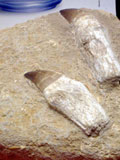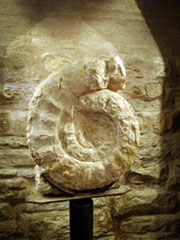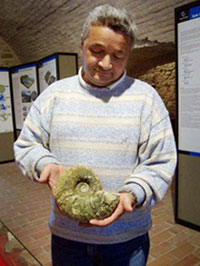 |
| As a child, Domenico Bei fostered his love
of nature by exploring the rocky slopes of Monte Nerone in
central Italy.
He picked up souvenirs on many of his journeys around the
mountainside and after a few years of exploring, Bei, a native
of the small Marche
village of Apecchio, had acquired an impressive
collection of interesting and beautiful rock formations. |
|
 |
The Fossil Museum at Ubaldini Palace
Photo By Jana Konys |
|
 |
Dinosaur Claws
Photo by Jana Konys |
|
It wasn’t until years later
— after much more exploring and research — that Bei came to
realize that his personal collection of natural treasures
held vital information about Italy’s past.
What Bei believed to be interesting rocks were actually fossils
that had been resting on Monte Nerone for millions of years.
|
|
| “I didn’t know they were fossils
when I picked them up,” explained Bei. “Years later, a priest
came to bless my home on Easter, noticed the pieces on my
dresser, and wanted to go to the mountain to see more. This
is how I began to dig deeper.”
Thanks to Bei’s careful handling, the fossils remained intact.
The pieces are now part of a larger collection of fossils
that are on display in a museum in Bei’s home town.
The fossil museum is located within the walls of the Ubaldini
Palace, a medieval castle that was once the home of Apecchio’s
founding family. Bei holds the official title of museum curator
as he found and examined almost all of the pieces.
The stone walls and floors of the fossil museum were once
a part of the Ubaldini family’s dungeon but now the ceilings
in the frigid room are lined with spotlights projecting a
bright aura in the underground museum. |
 |
One-of-a-kind Fossil
Photo by Jana Konys |
|
|
 |
Domenico Bei Holding a Fossil
Photo by Jana Konys |
|
Unlike intricate exhibits
that can be found at larger museums, the displays at the Ubaldini
Palace appear simple at first glance, but actually contain
fascinating and one-of-a-kind fossils that help to paint a
clearer fresco of this ancient land’s history. Rows of rectangular
glass cases lead spectators from room to room. Hundreds of
stone slabs fill the cases, each containing an imprint left
behind by an ancient creature.
Bei’s fossils look like giant white spirals, reminiscent
of snails or hermit crabs that can be found near the ocean
today. Visitors learn that this is because the Marche region
of Italy was once completely flat and submerged beneath the
sea. Sea creatures that thrived during the Jurassic period
left behind fossils when the Apennine Mountains were formed,
almost 50 million years ago.
During the 1950s and ’60s, the town made an effort to clean
out the Ubaldini Palace, but the dungeon of the ancient structure
remained closed even after it was restored. Then, in the 1980s,
Apecchio hosted a truffle fair, and the dungeon was opened
as an attraction for visitors. |
|
| Not many people were interested
in exploring the empty dungeon, so Bei proposed showing off
some fossils. He set up a small table displaying a small part
of his collection, and people became very interested. They
wanted to see more.
Now the Ubaldini dungeon is home to Bei’s complete collection,
as well as fossils from around the world.
Despite its small town location, the fossil museum has been
visited by scientists from all over the world, comparing the
fossils found in their respective nations to the ones found
in Italy. Bei remembers a time when the town of Apecchio was
skeptical of the impact the museum was making on the world
of paleontology, but minds were soon changed when the museum
began to attract experts.
“In the beginning, Apecchio said we were the crazy ones who
went up on the mountain to find stones that were without importance,”
Bei recalls. “They said we would be better off searching for
truffles because at least you can eat truffles…but as time
went by they saw that scientists came here, that geologists
and paleontologists came here to study.
“Apecchio realized that it was important.” |
 |
Fossils in Case at Ubaldini Museum
Photo by Jana Konys |
|
|
 |
The Ubaldini Bell
Photo by Jana Konys |
|
Unlike many of the foreign experts
who have traveled to Apecchio, Bei did not study paleontology
in school. His avid interest and knowledge of fossils was
born out of a childhood love of nature and escalated as his
findings were recognized as significant. He researched and
taught himself paleontology while collecting what is now a
huge library of paleontology reference books.
“I liked nature so I went walking on mountains, found these
things and collected them,” explained Bei. “My interest began
to grow larger and larger, so I started studying.”
Apecchio is not the only place in Italy that boasts such
historical gems. The country as a whole — already rich in
history and culture — has recently dug further into its past
to discover startling fossils that have had a profound impact
on the world of paleontology.
Scientists were baffled five years ago when an amateur paleontologist
unearthed the completely intact remains of a baby dinosaur
just north of Naples. This finding was especially exciting
because the remains included pieces of soft tissue, which
helped explain more about the true biology of dinosaurs. |
|
| Many experts agree that this
dinosaur, which they have named Scipionyx, can potentially
disprove two very accepted theories about dinosaurs. The biology
of Scipionyx creates a strong sense of doubt concerning what
was thought to be a close ancestral relationship between dinosaurs
and birds and also stirs doubts regarding the theory that
dinosaurs were warm-blooded.
Bei’s most prized fossil is a large crustacean called Hybopeltoceras.
It is the most intact fossil in the museum. It also holds
sentimental value for Bei because he spent a great deal of
time cleaning out the intricate spirals that make up the fossil.
He finds great satisfaction in his work, however difficult
and miniscule it is, but is made even happier when others
also appreciate his efforts.
“In our town, there should also be something that gives Apecchio
an importance. The fossil museum brings people here for reasons
other than tourism,” said Apecchio resident Luciano Granci.
“They come for science. These things here are not just rocks;
they are an important part of our history.” |
 |
|
 |
|

